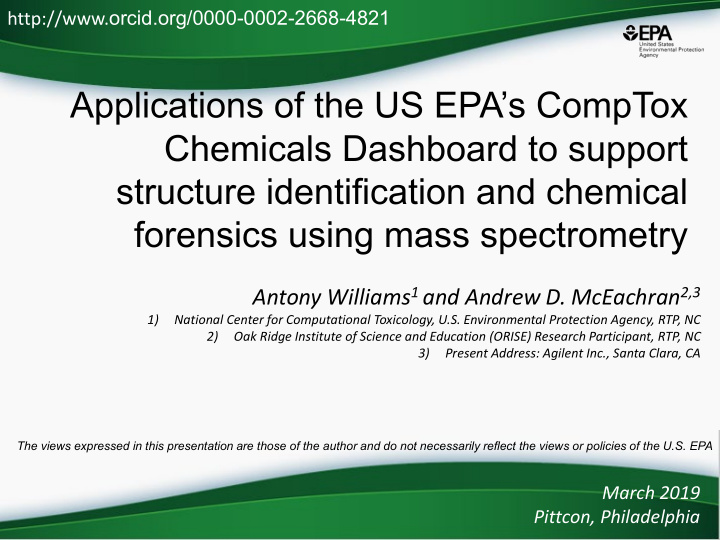



http://www. orcid.org/0000-0002-2668-4821 Applications of the US EPA’s CompTox Chemicals Dashboard to support structure identification and chemical forensics using mass spectrometry Antony Williams 1 and Andrew D. McEachran 2,3 1) National Center for Computational Toxicology, U.S. Environmental Protection Agency, RTP, NC 2) Oak Ridge Institute of Science and Education (ORISE) Research Participant, RTP, NC 3) Present Address: Agilent Inc., Santa Clara, CA The views expressed in this presentation are those of the author and do not necessarily reflect the views or policies of the U.S. EPA March 2019 Pittcon, Philadelphia
National Center for Computational Toxicology • National Center for Computational Toxicology established in 2005 to integrate: – High-throughput and high-content technologies – Modern molecular biology – Data mining and statistical modeling – Computational biology and chemistry • Researching computational approaches to quickly evaluate the safety of chemicals for potential risk. • Outputs: a lot of data, models, algorithms and software applications
CompTox Chemicals Dashboard • A publicly accessible website delivering access: – ~ 875,000 chemicals with related property data – Searchable by chemical, product use, gene and assay (ToxCast) – Experimental and predicted physicochemical property data – “Bioactivity data” for the ToxCast/Tox21 project – Generalized Read-Across (GenRA) module – Links to other agency websites and public data resources – “Literature” searches for chemicals using public resources – “Batch searching” for thousands of chemicals – DOWNLOADABLE Open Data for reuse and repurposing 2
CompTox Chemicals Dashboard https://comptox.epa.gov/dashboard 3
Search Chemicals 4
Detailed Chemical Pages 5
Access to Chemical Hazard Data 6
In Vitro Bioassay Screening ToxCast and Tox21 7
Sources of Exposure to Chemicals 8
MS-Ready Mappings 9
Specific Data-Mappings “MS-Ready Structures” 10
MS-Ready Publication https://doi.org/10.1186/s13321-018-0299-2 11
MS-Ready Mappings Set 12
Mass and Formula Searches Supporting Mass Spectrometry 13
Advanced Searches Mass Based Search 14
Advanced Searches Mass Based Search 15
Advanced Searches Mass Based Search 16
Batch Searching • Singleton searches are useful but we work with thousands of chemicals! • Typical questions – What is the list of chemicals for the formula C x H y O z – What is the list of chemicals for a mass +/- error – Can I get chemical lists in Excel files? In SDF files? 17
Batch Searches 18
Batch Searches 19
Batch Searching Formula/Mass 20
Excel Output 21
Suspect Screening and Non-Targeted Analysis Workflow Non-Targeted Analysis Color Key Suspect Screening Raw Samples Processed Features Red = Analytical Chemistry Blue = Data Processing & Analysis Extracted Samples Prioritized Features Purple = Mathematical & QSPR Modeling Raw Features Predicted Formulas Green = Informatics & Web Services “Molecular Features” Candidate Structures DSSTox Chemical Database Sorted Structures Predicted Retention Times Matched Formulas Mapped Structures Predicted Mass Spectra Prioritized Structures Predicted/Observed Functional Use (using ToxPi) Predicted/Observed Media Occurrence Confirmed Structures (using ToxCast standards) Methodological Concordance Predicted Concentrations Top Candidate Structure(s) 22
MS-Ready Structures Underpin Analysis 23
MS-Ready Structures Underpin Analysis 24
The Dashboard to Support MS-Analysis MS-Ready Structures Underpin Analysis 25
MS-Ready Mappings • Input Formula: C10H16N2O8: 3 Hits 26
MS-Ready Mappings • Same Input Formula: C10H16N2O8 • MS Ready Formula Search: 125 Chemicals 27
MS-Ready Mappings • 125 chemicals returned in total – 8 of the 125 are single component chemicals – 3 of the 8 are isotope-labeled – 3 are neutral compounds and 2 are charged 28
Complexity to Simplicity 93 Chemicals – 7 in EPAHFR 29
Complexity to Simplicity 93 Chemicals – 7 in the list 30
Searching batches Formula (or mass) searching 31
Downloadable Data 32
Work in Progress • CFM-ID – Viewing and Downloading pre-predicted spectra – Search spectra against the database • Retention Time Index Prediction • Structure/substructure/similarity search • Generation of MS-ready structures: – Upload file, download results – Service based generation 33
Predicted Mass Spectra http://cfmid.wishartlab.com/ • MS/MS spectra prediction for ESI+, ESI-, and EI • Predictions generated and stored for >700,000 structures, to be accessible via Dashboard 34
Predicted Mass Spectra Library Fragmentation Spectra (20eV) Match Score Observed Fragmentation Spectra (20eV)
Search Expt. vs. Predicted Spectra
Prototype Development 37
Prototype Development 38
Conclusion • The CompTox Chemicals Dashboard provides access to data for ~875,000 chemicals • Multiple prediction models available for data gap filling – OPERA models and TEST models – PhysChem and Tox endpoints – Models based on in vitro data – classification models – Generalized Read-Across development in progress • 2 years development as a CompTox Integration Hub 39
Acknowledgements • IT Development team – especially Jeff Edwards and Jeremy Dunne • Chris Grulke for the ChemReg system • NERL colleagues – Jon Sobus, Elin Ulrich, Mark Strynar, Seth Newton 40
Contact Antony Williams US EPA Office of Research and Development National Center for Computational Toxicology (NCCT) Williams.Antony@epa.gov ORCID : https://orcid.org/0000-0002-2668-4821 41
Recommend
More recommend